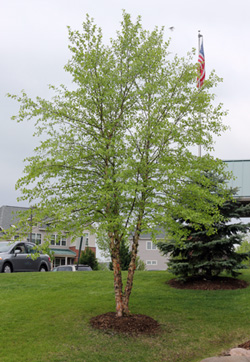
There are many species of birch native to the northern hemisphere. Betula nigra is one native to flood plains and swamps of the eastern US. This primarily streambank tree is most abundant in the hot, humid Southeast, but ranges from New England to northern Florida, and as far west as southern Minnesota and east Texas (zones 4-9). In Wisconsin, its natural northern limit is the terminal moraine of the last glaciation. This tree usually goes by the common name river birch but it is sometime referred to as water birch. The species name nigra refers to the black color of the mature bark of the wild species.
This deciduous tree has limited usefulness for timber but because of its graceful form and attractive bark it is frequently used in ornamental plantings in decidedly less moist conditions from which it originated, especially at the northern and western extremes of its natural range. It is one of the very best fast-growing shade trees, valued as a landscape tree for the colorful exfoliating bark which is particularly noticeable in the winter. It is one of the most culturally adaptable and heat tolerant of the birches and a good substitute for pest-prone paper and white birches. Another appealing feature is the shimmering contrast when the leaves flutter in the wind, revealing a lower leaf surface of a different color than the upper surface.
River birch is a medium to tall tree, growing 60-80 feet at maturity and about 40 wide. Trees typically live 50 -75 years. The trunk typically grows about 2 feet in diameter but occasionally will be much wider. This shade tree has highly symmetrical branching and upright pyramidal to upright oval form. Although it naturally forms just a single trunk, it is frequently sold in multiple-trunked form with two to five trunks per tree.

The bark on the trunk varies a lot among individual plants, ranging in color from silvery gray-brown to pinkish-brown when young, but always with darker, narrow, longitudinal lenticels. It is either scaly or peels off in curly papery sheets or flakes of gray, brown, salmon, peach, orange, and lavender. More mature trunks are rough and irregularly dark gray with deep fissures that may have some pink color in the crevices. Branches on older trees tend to be a smooth and shiny gray with much darker bark on the trunk. The very slender new twigs are a red-brown color, while thin branches are cinnamon-colored with many lenticels. Older branches may also be exfoliating – typically in a gray-brown-light orange mixture on the species form but in shades of cream, light orange, and lavender on selected varieties. The branches are not brittle, so are not prone to wind or ice damage. Twig and branch die-back is not uncommon and these dead parts tend to be messy as they shed readily.
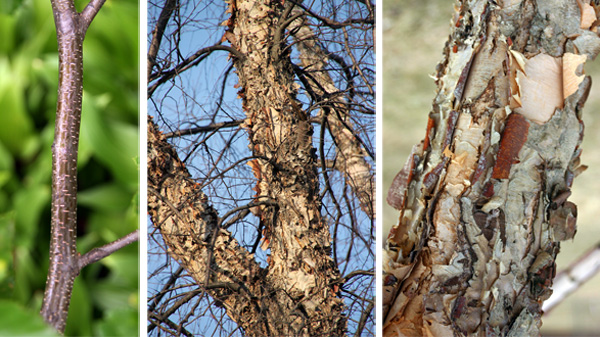

The leaves are typical of a birch – alternate, diamond-shaped, with a doubly serrated margin. They are a shiny, medium green color on the upper surface and a slightly paler, more silvery color on the underside. In the fall leaves may turn a bright golden yellow but often the fall color is dull and brownish-yellow. Leaves may also fall throughout the summer if the tree doesn’t get enough water. This species is a larval host plant for mourning cloak butterflies.
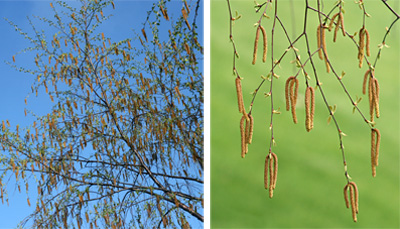
River birch is monoecious (separate male and female flowers on the same plant) with flowers arranged in catkins. The 3″ pendant male flowers are much more noticeable than the shorter, erect female catkins. The brownish male catkins occur in clusters at the ends of the twigs. They form in fall and mature to release pollen the following spring. Because the flowers are wind pollinated, the male catkins produce abundant pollen (a significant cause of seasonal allergies in the spring). The male flowers are shed soon after the pollen is released. The inconspicuous green female catkins occur on spur-shoots and appear with the leaves.
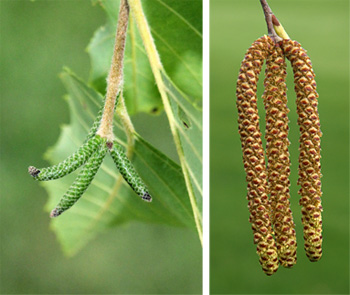
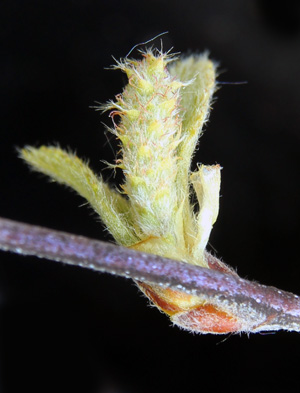
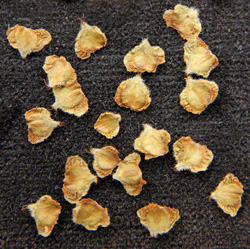
The numerous winged seeds mature in late spring (unlike all other birches which produce seed in the fall), packed between the bracts of the female catkins. The seeds are the largest of all birches native to the U.S. Heavy seed production occurs almost every year.

Seeds are disseminated by wind and water, germinating readily in moist soil. Seedlings grow quickly, so can be a bit “weedy” in the landscape. Many birds, including chickadees, song sparrows, wild turkey, pine siskins, and finches, eat the seed. The species can be propagated from seed, but commercial supplies are produced primarily from stem cuttings.
In early spring the tree produces copious amounts of sap, which Native Americans collected and boiled to make a sweetener similar to maple syrup. Because it will bleed profusely from the wounds during this time, river birch is best pruned in late summer or fall instead of late winter or spring.
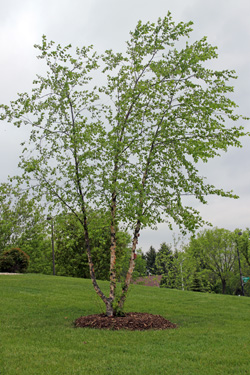
Because it is a large tree, river birch makes a wonderful specimen planting for larger properties. It can be used as a large focal point, to anchor the corner of a house on a large lot, or as a group of shade trees in a park or wide lawn. The high canopy casts light dappled shade when young but provides medium shade when older. This species is a good choice for low spots and wet soils, such as near streams or ponds. Because the trees use a lot of water, many shade-loving plants do thrive when planted under river birches. Hostas are tolerant of the dry shade created by river birch.
River birch should be planted in full sun in moist soils. It does well on clay as that type of soil retains moisture well. Although it is prefers wet soils this species is only moderately resistant to flooding but tolerates dry summers once established. Trees planted on moist soils live longer than those on dry sites. It transplants easily
River birch is has few insect or disease problems. Bronze birch borer (Agrilus anxius) is a significant pest of most birches but this species is the most resistant of the commonly grown birches. Iron chlorosis (leaves are chartreuse with darker veins) may be a problem on alkaline soils.
Several cultivars have been selected for ornamental use:
- Dura Heat® (‘BNMTF’) is a more heat and drought tolerant form with a densely pyramidal habit. The exfoliating bark is pinkish-orange.
- ‘Heritage’ is a popular, vigorous cultivar. It has heavily exfoliating bark, with layers of cinnamon, salmon and brown bark peeling back in big sheets to reveal creamy white inner bark. It looks best planted in multi-stemmed clumps.
- ‘Little King’ (Fox Valley™) is a dwarf form (15-20 feet tall) with good peeling bark.
– Susan Mahr, University of Wisconsin – Madison





 Silver Leaf
Silver Leaf Red Star Rust
Red Star Rust Tree Species Recommended for Fall Planting
Tree Species Recommended for Fall Planting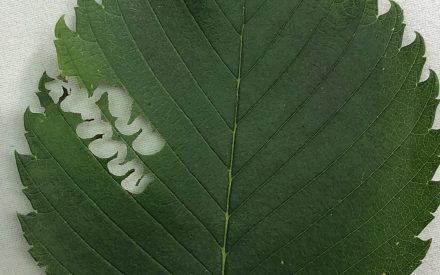 Elm Zigzag Sawfly
Elm Zigzag Sawfly


